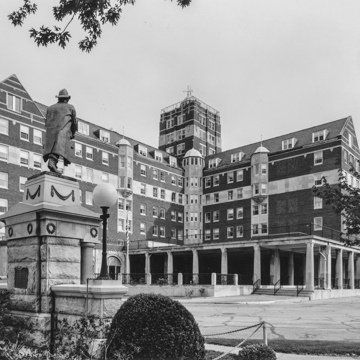You are here
Whitcomb Retirement Residence (Whitcomb Tower Retirement Center, Whitcomb Hotel)
The Whitcomb exemplifies the successful adaptation of an older hotel for reuse as a retirement center. It stands on a bluff above the St. Joseph Harbor, where the St. Joseph River flows into Lake Michigan. The original Whitcomb Hotel, known as the Whitcomb Sulphur Springs Hotel after being remodeled in 1875 from the still earlier St. Charles Hotel erected in 1868, was demolished to make way for this building. Irving K. Pond and Allen B. Pond and their associates Edgar Martin and Alfred L. Lloyd drafted plans for the Hotel Whitcomb. The Ponds had studied architecture and engineering at the University of Michigan and had associated in a partnership in Chicago that won acclaim for its designs of hotels, apartments, offices, and college buildings. The seven-and-a-half-story, highly stylized and modernized neo-Tudor hotel has a square tower topped with a bell-cast, copper-domed cupola. The brick exterior walls are trimmed with bands and stringcourses of white stone. On the west side are a stone colonnade, stylized stone relief carvings suggestive of the Streamline Moderne style, copper-topped oriels and bays, and a sunken court that once held an enclosed garden lounge and a dance floor. The hotel accommodated resorters and tourists who visited the nearby mineral springs, enjoyed the excellent view of Lake Michigan, and bathed at the beaches of this resort community. In the 1960s Michigan Baptist Homes Incorporated purchased the hotel and renovated it to serve as a retirement center.
Writing Credits
If SAH Archipedia has been useful to you, please consider supporting it.
SAH Archipedia tells the story of the United States through its buildings, landscapes, and cities. This freely available resource empowers the public with authoritative knowledge that deepens their understanding and appreciation of the built environment. But the Society of Architectural Historians, which created SAH Archipedia with University of Virginia Press, needs your support to maintain the high-caliber research, writing, photography, cartography, editing, design, and programming that make SAH Archipedia a trusted online resource available to all who value the history of place, heritage tourism, and learning.















